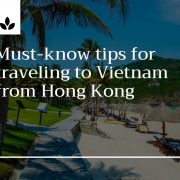Must-know tips for Vietnam traveling from Hong Kong
The number of Hong Kong visitors to Vietnam in recent years has increased dramatically. Hong Kong tourists are especially interested in visiting tourist destinations in Hanoi. The following are some helpful tips for traveling to Hong Kong for tourists. Let’s find out!
Tips on Vietnam visa in Hong Kong
Not everyone in Hong Kong will need a visa to Vietnam. If you are a Hong Kong citizen, you will surely need a Vietnamese visa. And here is the full guide to obtain a Vietnam visa for Hong Kong citizens.
But if you are a resident of Hong Kong, it may be not. To know more information, please check requirement at Vietnam-visa.com, a Vietnam visa official site, serving more than 200,000 groups of clients since 2007.
The easiest way to obtain a valid Vietnam visa in Hong Kong is to apply for a visa on arrival. This way is being selected by many international visitors thanks to the advantages this way brings: convenient, simple, fast and save time. Visitors applying for this type of visa are allowed to enter Vietnam through one of five international airports: Noi Bai – Hanoi, Cat Bi – Hai Phong, Da Nang, Cam Ranh – Khanh Hoa, and Tan Son Nhat – Ho Chi Minh City.
Please note that for this type of visa, travelers need to apply for an online visa, then receive a visa approval letter. After this document, visitors will be allowed to board the plane and be stamped visa at Vietnam airport.
► Full process of Vietnam visa on arrival is available here: How Visa on Arrival works.
Attractive Hanoi tourist sites for Hong Kong visitors
If your destination is Hanoi, you should not miss the following:
- Hanoi Cathedral (official name: St. Joseph Cathedral): The church was completed in 1886 – the cathedral of the Archdiocese of Hanoi, where the archbishop’s seat. This is also a long church in Hanoi, often take place the religious activities of the parishioners of the Archdiocese of Hanoi.
- Ho Chi Minh Mausoleum (Ba Dinh District)
- Hanoi Railway Station was built and completed in 1900, with the largest scale of Indochina in that period.
- The Ceramic road was built and completed in 2008 on the occasion of the 1000th anniversary of Thang Long – Hanoi. It is recognized by the Guinness World Records as the longest ceramic picture in the world.
- Phu Tay Ho is located on the large peninsula between West Lake, worshipping Princess Lieu Hanh, a legendary character, and one of four immortal saints in the belief of the Vietnamese. On the full moon, or early in the month, the people come here to worship.
- Hang Dau Tower is a construction work in 1894, located at the crossroads of the ancient streets of Hang Than, Hang Luoc, Hang Giay, Hang Dau, Quan Thanh and Phan Dinh Phung.
- Government Guest House – No. 12 Ngo Quyen, formerly mistaken for Tonkin. After the revolution in August 1945, this house was the office of the Government of the Democratic Republic of Vietnam, where President Ho Chi Minh worked from August 1945 to 1946. Now, this place becomes one of the places where brides and grooms take their wedding photos next to the flower garden.
- Ly Thai To statue is located in Ly Thai To Flower Garden. The flower garden is located on Dinh Tien Hoang Street, Hoan Kiem District, in the heart of Hanoi, Vietnam. The statue was cast in solid copper, which was built in 2004.
- Long Bien Bridge is the bridge connecting Hoan Kiem District with Long Bien District, built by French (1898-1902).
- Vietnam Museum of History is the place where the artifacts, reflecting the cultures and history of the country’s founding and defending, have been preserved, from the beginning of the country to the birth of the Democratic Republic of Vietnam.
- Ham Long Church is one of the most beautiful churches in Hanoi, with two fronts located on the streets of Ham Long and Ngo Thi Nham. This is also where many brides and grooms choose to hold a wedding. The cathedral has a large space, decorated with Phanxico style rope-strings, both ancient and modern. For many young people, perhaps this area is famous for its pigeon dumplings sold opposite.
- Dong Xuan Market is one of the largest markets in Hanoi, the largest market in the Old Quarter. The market has existed for hundreds of years, since the feudal Nguyen. In general, this market is only for foreign buyers and tourists.
- Friendship Cultural Center is located at 91 Tran Hung Dao Street, Hoan Kiem District, Hanoi. It is an architectural and cultural project for art performances, scientific conferences, and exhibitions. The project was started on January 1, 1978, on the foundation of the Hanoi War Veterans’ Association (destroyed by bombs during World War II), and completed on September 1, 1985.
- The flagpole of Hanoi – also known as the Hanoi Tower – is a towering structure built at the same time as Hanoi, under the Nguyen Dynasty (started in 1805, completed in 1812). The flagpole architecture consists of three pillars and one column, which is considered one of the symbols of the city. The building is located on Dien Bien Phu Street – opposite Lenin Park and on the premises of the Museum of Military History of Vietnam.
Wish you have a fun trip!



